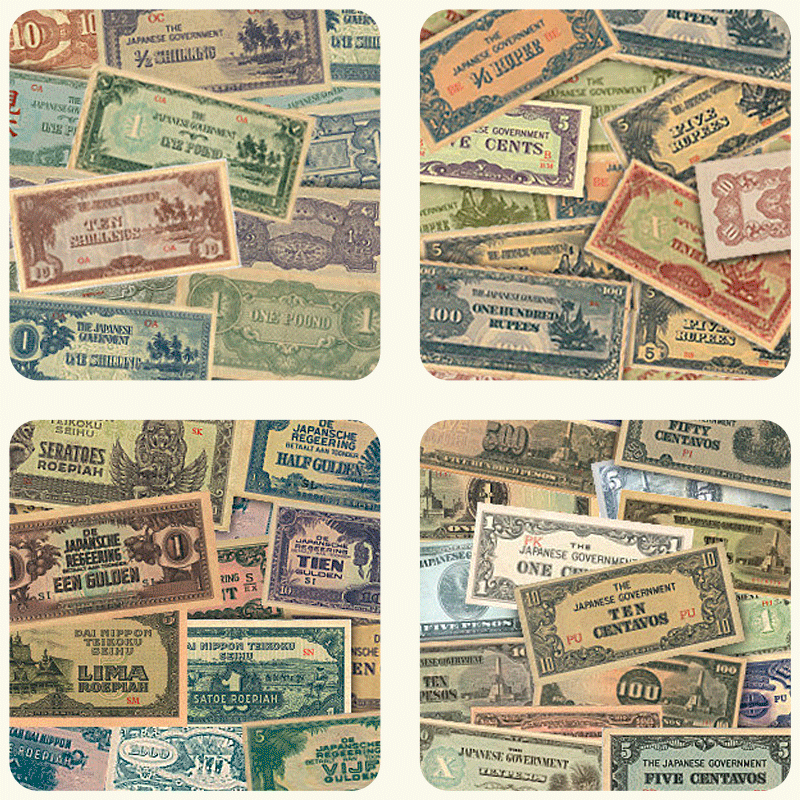Online store - OPEN NOW
Step back in time and explore a treasure trove of history in our online store for collectors, historians, and enthusiasts!
Discover Authentic Japanese Invasion Money (JIM)
Dive into the fascinating era of World War II with our extensive range of Japanese Invasion Money (JIM) from Burma, Malaya, the Netherlands East Indies, Oceania and the Philippines. We also have a limited stock of other items such as tokens, Allied Military Currency, Military Payment Certificates, World War II-era Chinese and Japanese banknotes, and a small range of books and memorabilia.
With hundreds of items to choose from, you’re sure to find the perfect addition to your collection or the ideal gift for a fellow history enthusiast.
Shop Now and Own a Piece of History!
Don’t miss out on these rare and remarkable items. Visit our online store today and bring a piece of the past into your hands.


What is Japanese Invasion Money?
Step into a gripping chapter of World War II history with Japanese Invasion Money (JIM) — a currency issued by Japan to replace local money in areas they occupied or intended to conquer. Officially called Southern Development Bank Notes, these banknotes symbolized Japan’s efforts to dominate the economies of Asia during the war.
The Strategy Behind the Money
JIM wasn’t just currency; it was a weapon. By introducing these notes, Japan effectively rendered local currencies worthless, undermining the economies of occupied territories. Enforced with an iron fist, Japanese troops mandated the exclusive use of JIM, often referred to as “Mickey Mouse” or “banana” money. The penalties for defying this mandate were severe, including imprisonment and execution.
A Vision of Asian for Asians?
At the heart of Japan’s strategy was a vision championed by Prime Minister Matsuoka Yosuke: the Greater East Asia Co-Prosperity Sphere. This ambitious plan aimed to unite Asian nations under Japanese leadership, promising independence from Western powers. However, despite its lofty rhetoric of “prosperity for all,” Japan’s vision imposed a clear hierarchy, with its allies playing subordinate roles in this new order.
By the war’s end, Japanese Invasion Money had been issued in numerous regions, including: The Philippines, Burma (Myanmar), Malaya (Malaysia, Singapore), Dutch East Indies (Indonesia) and Oceania: British New Guinea, Solomon Islands, Gilbert Islands, and Australia.
The Legacy of JIM
After the war, JIM notes became prized souvenirs brought back by Allied soldiers, particularly Australians, as tangible evidence of Japan’s expansive wartime ambitions—including their planned invasion of Australia.
Japanese Clay Coins - Maboroshi - Japanese Ceramic Coinage - Circa 1945
The mysterious Japanese ceramic coins (Japanese clay coins) from 1944–45 provide a snapshot of a brief and fascinating part of Japanese numismatic history – the fragile link between war and peace in Japan.
‘Maboroshi’ is a Japanese term to describe these coins and translates as the phantom. These small ceramic coins (clay coins) are undoubtedly mysterious, and like a ghost in the night, as soon as they appeared, they were gone. Mystery surrounds their existence, use and destruction at war’s end.
This Japanese clay coin Book tells the story – the trials and tribulations of these coins from their concept to production and destruction. This work is a culmination of years of research and draws on information pieced together from an unpublished, hand-written manuscript; video recordings of first-hand accounts; information provided by coin dealers, ceramic specialists and experts in Japanese numismatics; records and information provided by Japan Mint, Osaka.
Latest News – 500,000 Phantom Ceramic Coins Unearthed in Kyoto.
The Collector’s Guide to Japanese Invasion Money book - 2nd Edition
It is essential for collectors and dealers and includes:
- Quantities, blocks and detailed values
- Numerous photos of bank notes and varieties
- Reference codes from the Standard Catalogue of World Paper Money and The Catalog of Japanese Coins and Bank Notes to assist collectors in identifying notes and varieties
- A new grading guide specifically for JIM and a quick reference table to assist with self-grading
- Specimen and counterfeit detecting information
- Updated collectors’ tables including newly discovered blocks and numbers and hard-to-find blocks and serial numbers highlighted.
This book provides a snapshot of JIM in World War II, beyond a catalogue and reference book. It provides an ‘experience’ through stories of the day, propaganda, newspaper articles, artwork and details the introduction and the aftermath of Japanese Invasion Money.
大東亜戦争 軍票カタログ(日本語版)
The Catalogue of Japanese Military Notes of The Pacific War
軍票カタログの最新版! どのカタログよりも新しく、細かく分類された記号と番号、グレード別の価値が多数のカラー写真と共に記載されています。
ご購入はこちらから!
Japan Co-Prosperity Sphere Commemorative Issue
Unique token series based on Japanese Invasion Money from World War II.
8 different tokens to collect
• Burma • China • Japan • Malaya • Netherlands East Indies • Oceania • Philippines • U.S.S.R.
Proudly designed and made in Australia.
Each token is supplied in a coin capsule along with a descriptive card and envelope.
These are essential for collectors of Japanese Invasion Money from World War II.

Netherlands East Indies
The design of the Netherlands East Indies Peace gulden has been inspired by The Japanese Government coins, issued in World War II.
The Arjuna illustration was hand-drawn by Brisbane-based designer, Gregory Hale. He used an original Japanese Government 10 sen coin as his reference to faithfully recreate the illustration.
Arjuna is a character from a traditional Javanese wayang kulit (shadow puppet) fable. Japanese coins featuring Arjuna were minted in 1943 and 1944. Many of these mysterious coins were lost at sea en route to Java, making them rare and valuable to collectors.
Size: 34 mm Ø. Includes coin capsule.
Interleaves collector’s table in Excel or PDF
Special thanks to The Australian War Memorial in Canberra




